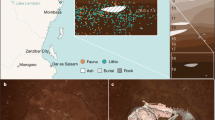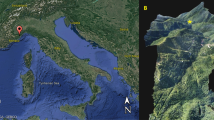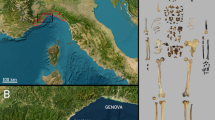Abstract
Decorations on the bodies of newborns indicate that they were probably important in their community.
Several adult graves from the Stone Age (Upper Palaeolithic period) have been found but child burials seem to be rare, which has prompted discussion about whether this apparently different treatment of infants could be significant1,2. Here we describe two recently discovered infant burials from this period at Krems-Wachtberg in Lower Austria, in which the bodies were covered with red ochre and decorated with ornaments and were therefore probably ritually buried. These findings indicate that even newborns were considered to be full members of these hunter−gatherer communities about 27,000 years ago.
Similar content being viewed by others
Main
The Upper Palaeolithic sites in eastern Austria have been reinvestigated over the past decade. The loess sequences around Krems have been of particular interest, with surveys, test trenches and drilling-core analysis yielding insight into settlement patterns between the rivers Danube and Krems. Excavations at Krems-Hundssteig3 and Krems-Wachtberg4 (see supplementary information) have provided detailed information about the spatial organization of these camps.
In the first campaign at Krems-Wachtberg, an extraordinarily well-preserved living floor, radiocarbon dated at 26,580 ± 160 years before present (specimen Poz-1290) was found. It contained items of Gravettian (Upper Palaeolithic) culture, such as lithic artefacts and ornaments, as well as faunal remains, charcoal, ochre and a fired piece of clay bearing a human fingerprint5. A double infant burial was discovered in 2005 ('burial 1') and a single infant burial in 2006 ('burial 2').
Each burial was recovered as a block, which was analysed by computer tomography and laser scanning of the surface layers. Burial 1 was in a 40-cm-long pit and the bodies were overlaid with an adult mammoth scapula, supported by part of a tusk. The two skeletons, which were very well preserved, were embedded in red ochre; individual A (Fig. 1a, bottom) was decorated with more than 30 ivory beads (shown enlarged in Fig. 1c). The developmental stage of a deciduous incisor of individual B (Fig. 1a, top) allowed the estimation of the age at death to be perinatal (ninth to tenth lunar month). The equal lengths of both right femora indicate that the newborns were the same age at death; their contemporaneous burial suggests that they were twins. The auditory ossicles of individual A (Fig. 1a, bottom) were also recovered.
a, Double burial of two newborns (burial 1, excavated in 2005). These are in a flexed position on their left side, with their skulls oriented to the north and facing east. More than 30 ivory beads were found near the pelvis of individual A (at the bottom of the photo; enlarged in c). Both were embedded in a thick layer of red ochre and covered by the scapula of a mammoth. b, Burial of an infant embedded in a thick layer of red ochre (burial 2, excavated in 2006) in a flexed position on its right side; the skull is oriented to the south. (Photographs: Natural History Museum of Vienna.) c, Detail of ivory beads associated with individual A in burial 1 at Krems-Wachtberg. (Photograph: Prehistoric Commission, Austrian Academy of Sciences.) Scale rules marked in 5 cm (a,b) and 1 cm (c).
Burial 2 (Fig. 1b), located about 1 metre north of burial 1, is of a single individual. From the degree of mineralization of the upper incisors, this infant must have died at 0−3 months after birth. The subsidence of the cultural layer above the pits provides evidence that all three infants were buried at the start of the settlement at the site.
The technology, the structure of the camp, and the evidence of ritual activities (use of red ochre, ornaments and the covering of the twin burial with a mammoth scapula) at Krems-Wachtberg attest to its close affinity with the South Moravian sites Dolní Věstonice and Předmostí6.
Nothing comparable to these burials of such young Upper Palaeolithic individuals has been found before. They therefore expand the debate about Gravettian ritual(s) and add to the sparse sample of Palaeolithic human remains found so far in Europe7. Moreover, these well-preserved fossils of extremely young individuals will contribute important evidence to the study of the ontogeny of early modern humans.
References
Trinkaus, E. & Svoboda, J. Early Modern Human Evolution in Central Europe. The People of Dolní Věstonice and Pavlov (Oxford Univ. Press, 2006).
Zilhão, J. & Trinkaus, E. Portrait of the Artist as a Child (Trabalhos de Arqueologia 22) (Instituto Português de Arqueologia, Lisboa, 2002).
Neugebauer-Maresch, C. Preistoria Alpina 39, 165–173 (2003).
Einwögerer, T. Die Jungpaläolithische Station auf dem Wachtberg bei Krems, NÖ (Mitt. Prähist. Komm. Österr. Akad. Wiss. 34) (Akademie der Wissenschaften, Wien, 2000).
Svoboda, J., Neugebauer-Maresch, C., Králík, M., Einwögerer, T. & Novotný, V. Přehled Výzkumů 45, 256–259 (2004).
Svoboda, J. Přehled Výzkumů 46, 63–82 (2004).
Teschler-Nicola, M. & Trinkaus, E. J. Hum. Evol. 40, 451–465 (2001).
Author information
Authors and Affiliations
Corresponding author
Ethics declarations
Competing interests
The authors declare no competing financial interests.
Supplementary information
Supplementary Figure 1
Krems-Wachtberg 2005: View into the excavation pit from the east. (PDF 196 kb)
Supplementary Figure 2
Krems-Wachtberg 2005-2006: Plot of the North Profile generated from the database with horizons and collected samples. (PDF 123 kb)
Supplementary Figure 3
Krems-Wachtberg 2005-2006: Surface models showing two subsequent phases of the main find layer and the features Pit 3, (Double-) Burial 1 and Burial 2. (PDF 166 kb)
Supplementary Figure 4
Krems-Wachtberg 2006: Detail of the West Profile showing Pit 3 as well as the main cultural layer AH 4 and archaeological horizon AH 5. Above Pit 3 several debris layers are visible. (PDF 158 kb)
Rights and permissions
About this article
Cite this article
Einwögerer, T., Friesinger, H., Händel, M. et al. Upper Palaeolithic infant burials. Nature 444, 285 (2006). https://doi.org/10.1038/444285a
Received:
Accepted:
Published:
Issue Date:
DOI: https://doi.org/10.1038/444285a
This article is cited by
-
Anatomically modern human in the Châtelperronian hominin collection from the Grotte du Renne (Arcy-sur-Cure, Northeast France)
Scientific Reports (2023)
-
Miniaturization and Abstraction in the Later Stone Age
Biological Theory (2023)
-
The Ornaments of the Arma Veirana Early Mesolithic Infant Burial
Journal of Archaeological Method and Theory (2023)
-
An infant burial from Arma Veirana in northwestern Italy provides insights into funerary practices and female personhood in early Mesolithic Europe
Scientific Reports (2021)
-
Tracing human mobility in central Europe during the Upper Paleolithic using sub-seasonally resolved Sr isotope records in ornaments
Scientific Reports (2020)
Comments
By submitting a comment you agree to abide by our Terms and Community Guidelines. If you find something abusive or that does not comply with our terms or guidelines please flag it as inappropriate.




